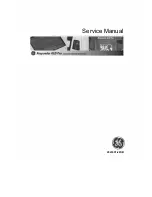
Section 3
Installation
Environmental Considerations
22
Thermo Scientific Orion
2230XP Silica Analyzer
Installing the Reagents
The analyzer reagents startup kit contains all the necessary reagents for the specific
application. The reagents and calibration standards are supplied in ready-to-use bottles that
can be replaced directly onto the cap assemblies.
Follow the markings to install each solution into the respective feed line in the analyzer.
Connecting Power to the Analyzer
CAUTION
Operational Safety and General Precaution
Only trained technical personnel should perform installation, electrical wiring and maintenance
of this product. Proper handling is required to avoid ESD (Electrical Static Discharge), as the
internal electronic components on the circuit boards can be damaged by static electricity. It is
recommended that before touching any electronic components, (such as printed circuit cards
and the components on them) you should discharge static electricity from your body. This can
be accomplished by touching an earth-grounded metal surface such as the chassis of an
instrument, metal conduit, or pipe.
The analyzer is equipped with a three terminal power connector strip located in the electronics
enclosure as shown in Figure 9.
IT IS HIGHLY RECOMMENDED THAT PROVISIONS FOR AN EXTERNAL CUSTOMER-
SUPPLIED POWER SWITCH OR BREAKER BOX (WITH COMPLETE CB SPECIFICATION),
CLEARLY MARKED FOR THE ANALYZER AND WITHIN REACH OF THE USER, BE
PROVIDED TO ALLOW REMOVING POWER DURING SERVICE.
The analyzer has been designed to be hard-wired with provisions for the AC power lines to be
routed in conduit pipes connecting to the ¾" FNPT hubs located on the left side of the
electronics enclosure. See Figure 7.
When using line cords, use only certified power cords of 3 core, min 0.75 mm
2
/ 18AWG, min.
temperature of 75°C, H05VV-F.
The power safety ground must be provided for proper operation.
















































